Data analysis and findings Assignment 2020
The chapter of data analysis and findings is considered as the most important in the research study, throughout the study there will be a complete description of data collection and data analysis.
The primary data analysis has been carried out through a survey session by distributing the questionnaire among 50 employees of Indigo.
5 HR manager has also been interviewed based on evaluating the impact of training and development in the airline industry, particularly in Indigo airlines.
Moreover, this chapter will also present findings along with discussions. Extracting all the information from the employees and the managers helps in performing the study and determine results that help in conducting this research successfully.
Primary data analysis
In the present research study, primary data has been collected directly from the respondents which comprised of managers and employees of Indigo.
The two elements of primary data are quantitative and qualitative. In this present study, both qualitative, as well as quantitative analysis, have been developed to obtain feedback from the managers as well as employees in terms of completing the study appropriately.
Quantitative analysis has helped the observer in presenting a better understanding of the viewpoints of employees of Indigo concerning determine the effectiveness of training and development in their skill sets.
Qualitative analysis has rather provided descriptive facts about evaluating the impact of training and development among employees of Indigo airlines.
To conduct the survey session, a total of 50 employees were targeted. A questionnaire was distributed among the customers in terms of identifying the effectiveness of training and development in the airline’s industry.
This section presents the analysis of data collection.
- What is your Gender?
- Male
- Female

Source: Author
From the above graph, it can be concluded that the number of female employees was more in IndiGo as compared to the men employees.
56 % of the employees were female who took participation in the questionnaire survey and 44 % of the employees were male who participated in the questionnaire survey.
Both men and female respondents replied that the training and development have made it easier for them to acquire new skills and knowledge that helps them in performing with higher accountability and achieve the set objectives of the firm.
Moreover, the female respondents also responded that training and development eventually help them in performing the complex task to achieve significant results.
- What is your age?
- 18-29 years
- 30-39 years
- 40-49 years
- Above 50 years

Source: Author
Based on the above graph, it has been noticed that the 48 % of the number of participants fall under the age bracket of 18 to 29 years, followed by 36 % of the participants who fall under the age group of 30 to 39 years, 12 % of the participants who fall under the age group of 40 to 49 years and 4 5 of the participants only fall under above 50 years age bracket.
As a combined 84 % of the participants i.e. employees fall under the age group below 40 years, therefore, it can be said that the organisation has a very young workforce.
The age group plays a vital part in the survey process as because based on the age group of the people the management determines specific training module for the employees such as 84% of employees who falls under the combined age group of 18-39 years old are being provided with the technical training program.
- How long have you worked for Indigo Airlines?
- Less than 1 year
- 1-5 years
- 6-10 years
- More than 10 years
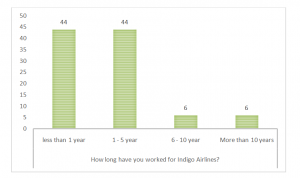
Source: Author
The above graph suggests that 44 % of the participants i.e. employees have been working for less than 1 year in this organisation whereas 44 % of the participants have been working for more than 1 year but less than 5 years in this organisation.
The percentage of the participants working above 5 years in this organisation dropped drastically as only 6 % of the participants have been working for more than 6 years but less than 10 years and similarly, 6 % of the participants have been working for more than 10 years.
The above graph indicates a trend that suggests that the employees normally leave this organisation even before they can complete 5 years in this organisation.
Evaluating the statistical data it has been identified that Indigo airlines mainly focus on developing a young and dynamic business environment where employees can learn and put their skills towards earning success for the management.
Furthermore, it can also be identified that Indigo airlines management are focusing towards building young management as because it helps them in fostering creative ideas and suggestions that help the management to grow and acquire future growth opportunities.
Whereas, the number of employees working over six years is less because this type of employees is resistance towards change or part of trainingas compared to new and young employees.
Hence, the number of people working within 1-5 years is more as compared to other years.
- On how many occasion have you undergone the training program conducted at Indigo airlines?
- One time
- Two times
- Three times
- More than three times
- None
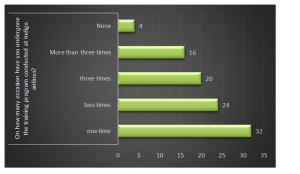
Source: Author
On the basis of the above graph, it can be explained that out of the 50 participants, 32 % of the participants have been part of the training program for one time, followed by 24 %, 20 %, 16 % and 4 % of the participants have been part of the training program for two times, three times, more than three times and none respectively.
The above graph indicates that the participation in the training program was widely distributed among the 50 participants as 48 out of 50 of the employees of IndiGo participated in the training program and they are even 2 candidates who did not even participate in the training program.
Evaluating the survey responses of the respondents it has been identified that most of the employees in Indigo have attended the training and development program for at least one time and based on them it has provided them immense benefits.
While asking if they would like to take participation in the training and development program the respondents replied that they would certainly do that.
- Which training and development program is most important according to you?
- Safety and emergency procedures
- Aviation security
- Crew resource management
- In-flight services
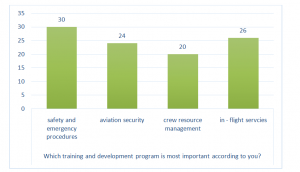
Source: Author
From the above graph, it is seen that 30 % of the respondents suggested safety and emergency procedures training programs are most important for them, followed by 26 % of the participants believed in-flight services training program is important for them, 24 % of the respondents explained aviation security training program is crucial for them and 20 % of the participants highlighted that crew resource management training program is vital for them.
The above graph indicates that all the four training programs such as safety and emergency procedures, in-flight services, aviation security and crew resource management provided by IndiGo are critical for the employees to ensure that the quality and standards set by this airline organisation can be met and the expectation of the consumers can be catered.
Moreover, Indigo airlines also arranged for a special training program for the employees to impart the knowledge of safety and emergency procedures.
The training and development of inbound crew members concerning safety and emergency procedures also help them in informing the passengers about the do’s and don’ts and maintain safety while travelling.
Another important factor that contributes towards the training and development among employees is in-flight service accommodation for the passengers.
Arranging in-flight services such as food, WIFI and TV sets provides relaxation to the passengers while travelling.
Moreover, providing a high quality of services also helps the passengers in building the brand image of the airlines firm and makes a repeat visit.
- What kind of training method do you prefer?
- On the job and technical methods
- Off the job and technical methods
- Off the job and non – technical methods
- On the job and non-technical methods

Source: Author
Based on the above graph, it is observed that 44 % of the participants preferred on the job and technical methods, followed by 24% of the respondents have replied that they prefer to have on the job non-technical methods.
Furthermore, evaluating the graphs it has also been identified that 20% of the respondents prefer to enrol themselves on off the job and non-technical method followed by 12% of respondents prefer to have off the job and technical methods.
Majority of the respondents preferred to have on the job and technical method because it helps them to increase their knowledge in regards to handling customer grievances, responding to their quarries along with maintaining in-flight services.
The respondents also stated that on the job technical training helps them to shape their skills and traits which aids them in performing the task with higher authenticity and accountability.
Evaluating the responses of the respondents it has also been identified that on the job training helps them in increasing their competency to maintain customer relationship along with providing the necessary information that helps them in attracting customers towards the airline business venture.
Whereas, the second-highest group of respondents replied that they prefer to have on the job non-technical training which builds their competency to look after management task and perform it within a limited period.
- What are the general complaints about the training session?
- Takes too much time off employees
- Too many gaps between employees and employer
- Training sessions are unplanned
- Boring and not useful
- Others, ____________
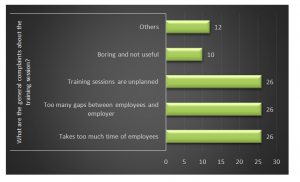
Source: Author
During the survey session, the employees were being asked what major general complaints they face during the training sessions, this question was asked to the employees in regards of understanding the factors that create hindrance to shape their skills.
Evaluating the graph it has been identified that combined of 78% of respondents feels that training session takes time, there are too many gaps between employees and employer and training session are unplanned.
Based on the responses of the respondents it has been identified that although the training and development session is useful it has certain limitations that need to be resolved to make it more significant and fruitful.
Moreover, it has also been identified that 10% of the employees feel that training and development session is boring and it does not provide any significant result that can help them in their near future.
Whereas, the rest of 12% of employees feel that the lack of expert trainers is one of the major reason as to why the training session is not becoming fruitful.
Other, reason also includes of lack of employee participation such as there should be interactive games session along with deep briefing session that could have made the training and development program successful.
- Does training help to improve the employee-employer relationship?
- Strongly agree
- Agree
- Neutral
- Disagree
- Strongly disagree
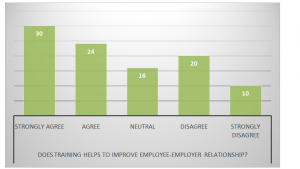
Source: Author
Evaluating the statistical graphs based on the responses of the respondents it has been identified that 30% of the respondents strongly agree that the training and development session helps in building the employee-employer relationship.
The reason behind this is both employer and employees spend time with each other during the training session, where they understand each other’s weakness and strengths.
Building understanding among each other helps them in performing the task and achieve the highest possible success.
Whereas, 24% of the respondents agree to this fact that training and development help in improving the employee-employer relationship among each other.
One to one interaction process along with sharing their thoughts and ideas improves collaborative nature among each other which helps them in achieving the business goal.
20% of the respondents disagree with the statement that training helps in improving the employee-employer relationship as because they feel that it takes time and during the decision making process conflict of interest arise among them.
- How often the training and development program is conducted in your organisation?
- Every month
- Every quarter
- Half-yearly
- Once in a year
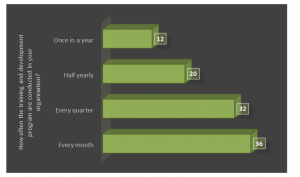
Source: Author
During the survey session, the respondents were asked how often the training and development program is conducted within the organisation, the purpose of this question was to understand the responsiveness of the organisation towards its employees.
36% of the respondents replied that training and development are conducted every month within the organisation. Moreover, it has also been identified that 32% of the respondents replied that training and development are conducted in every quarter.
Whereas, 20 % and 12% of the respondents replied that training and development within the organisation are performed half-yearly and in once a year respectively.
Majority of the respondents around 68% replied that as training and development are conducted every month it helps them in keeping themselves updating about the latest changes within the airline’s industry along with complying with the change.
Furthermore, it has also been identified that training and development every month also helps the employees in shaping their skills and understand its importance in terms of catering the needs of the passengers along with providing them highest facilities to gain their attention towards the firm.
Whereas, 20% of the employees responded that training and development within the firm ae conducted on a half-yearly basis.
The respondents further stated that as because the aviation industry is going through transformation hence it becomes necessary to conduct training every month for better skilled and qualified human resource.
- Does training and development help to increase the motivation level of employees?
- Strongly agree
- Agree
- Neutral
- Disagree
- Strongly disagree
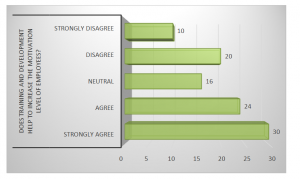
Source: Author
Interpreting the data it has been identified that 30% of the respondents feel that training and development do help in increasing the motivation level of the employees.
Based on the responses collected from the respondents it has been identified that training and development not only helps in shaping the skills of the employees but also it helps in shaping their characteristics which motivates them to work with higher accountability and integrity.
24% of the respondents replied that training and development does help in motivating them as because indulging in training session helps in acquiring knowledge and information which helps them in understanding the task and perform it to achieve success.
Contradictory to it, the respondents also stated that 20% of the employees disagree to the statement as because they feel that training only aims towards specifying the objectives of the management rather than briefing employees regarding their job roles.
- Are you satisfied with the present method of selection of candidates for training?
- Strongly agree
- Agree
- Neutral
- Disagree
- Strongly disagree

Source: Author
Evaluating the responses of the candidates in regards to this question, it has been identified that 30% of the respondents truly satisfied with the selection of the candidates, The employees briefed that all the employees are selected based on their skill sets and knowledge, hence it provides opportunities for the firm to recruit the best candidate within the firm.
24% of the respondents replied that they also agreed to the statement as because the training and development help the candidates to understand the essence of the topic and then perform the task.
The selection of candidates for training includes their background and experience that can assist them in understanding the job role.
Whereas, 20% of the respondents replied that they are not satisfied with the present method of selection of candidates for training as because they feel that candidates should be selected based on technical background experience for better understanding of aviation job.
- The training program helped to increase the productivity of both quality and quantity?
- Strongly agree
- Agree
- Neutral
- Disagree
- Strongly disagree

Source: Author
Evaluating the responses of the respondents it has been identified that 32% of employees strongly agreed to the fact that the training program helps in increasing the productivity of both quantity and quality.
20% of the respondents replied that the training program helps in developing the individual characteristics and shapes their skills which helps them in retaining quantity and quality.
Whereas, on the other hand, it has been identified that 16% and 12% of respondents stated that training and development fail to increase both the productivity of quantity and quality, as because due to elongated time it becomes harder to keep the focus of the employees in the training period.


